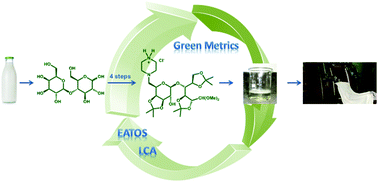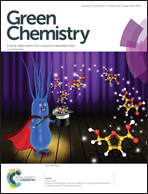Environmental sustainability assessment of a new degreasing formulation for the tanning cycle within leather manufacturing†
Abstract
The degreasing or defatting phase represents one of the most environmentally impacting steps in the entire leather manufacturing cycle. Indeed, the chemical compounds conventionally employed during this activity are significantly impacting, mainly as a consequence of their scarcity and slow biodegradability. The present work represents a limited part of the European Life+ project titled, “Environmentally-friendly natural products instead of chemical products in the degreasing phase of the tanning cycle”, which aims at proposing innovative degreasing formulations based on chemical compounds of natural origin. Particularly, newly synthesised lactose derivatives were thought to partially replace ethoxylated alcohols typically employed in commercial products. The aim of the present work is to present detailed and quantitative environmental assessments of the laboratory-scale preparation of the most promising formulation tested, designated EDF 20. This innovative formulation is based on a piperazinyl hydrochloride derivative of lactose, for which a four-step synthetic protocol has been optimized, and which was then mixed, in the last preparatory step, with further components to obtain an aqueous degreasing formulation with a reduced ethoxylated alcohol content. A preliminary environmental assessment limited to the chemical point of view was performed by employing the software EATOS (Environmental Assessment Tool for Organic Syntheses) in order to evaluate all of the chemicals used in the synthesis of the lactose derivative and in its work-up procedures. In order to assess the whole environmental and human health impacts associated with the production of the defatting agent, thus performing a cradle-to-grave analysis, the Life Cycle Assessment (LCA) methodology was applied, with the aim of furnishing quantitative and trustworthy data also related to further fundamental impact categories, such as those comprising energy consumption. This work represents the first example of an environmental assessment related to one efficient alternative to the conventional degreasing procedure within the leather manufacturing cycle. It will hopefully smooth the way towards the quantitative assessments of further alternative defatting procedures/products, which are proposed practically on a daily basis with the aim of significantly reducing the environmental loads of this tremendously impacting industrial activity.

- This article is part of the themed collections: International Symposium on Green Chemistry 2017 and 2017 Green Chemistry Hot Articles


 Please wait while we load your content...
Please wait while we load your content...